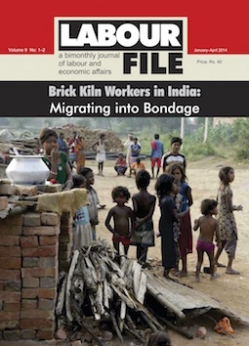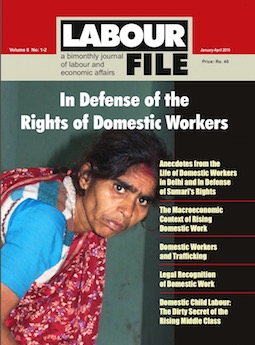The Right to Information Act and Labour
J John is Editor, Labour File. Email: jjohnedoor@mac.com . (J John)
The Right to Information Act (RTI) 2005 opens up many possibilities for gathering information— information that can rationalise and democratise the thinking process and actions of the government and the citizens. Yet, how far is this powerful tool being utilised to seek information? Does the working class really benefit from this Act? Do the trade unions make use of this Act to strengthen labour and improve the conditions of workers?
Is the working class and those who work for it — the trade unions — aware of all the existing rights and privileges? The Ministry of Labour has set up a Central RTI Cell, headed by the Central Public Information Officer, where applications under RTI are received. According to the information provided by the Central RTI Cell to Labour File, the Ministry of Labour received 37 applications in 2005-06, 399 in 2006-07 and 606 in 2007-08.
In this issue, Labour File looks at the various issues that could be and have been addressed through the RTI.
CS Venkata Ratnam, in `The Right to Information Act and the Employment Contract`, discusses the role of unions and how these could take key elements of the RTI Act as demands within collective bargaining agendas. In `Mega Projects and RTI`, Himanshu Thakkar explains the potential and limitations of the Act in the labour struggle as well as why it is a useful instrument for bringing greater transparency and accountability in the planning, decision-making and implementation processes for mega dams and big hydropower projects. Mohan Mani, in `Closure of Industries and the RTI`, explains why industrial closure is and has been a major challenge for the trade union movement from the inception of industrial development in the country. He shows how the involvement of multiple agencies in closures and the different geographical locations at which arbitration takes place make it extremely difficult for trade unions to keep pace with the closure exercise. In `Labour and the Right to Information Act`, Bharat Sangal describes how the RTI is different from other laws because it creates and codifies a right of citizens, and how it is a tool for empowerment of the have-nots and the victims of bureaucracy to obtain correct information about their relationship with their employer. Ashish Mittal, in `Occupational Safety and Health and Right to Information`, emphasises that the onus of improving the health of the workplace rests with all stakeholders, and that to take an active role in doing this, they must empower themselves with the knowledge and information, which can be gathered through the RTI Act. Meera Visvanathan, in `Workers Rights on Campus: JNU Students Geared Up`, recalls how in the struggle for the rights of campus contract workers, the information gathered through the RTI was strategically important for the struggle. She argues that although the RTI is not a form of struggle in itself, it is a useful enabling tool. In `Right to Information and Informal Labour`, Aheli Chowdhury explores how information accessed under the RTI Act has facilitated movements for the rights of workers of the unorganised sector (such as construction workers, domestic workers, rickshaw pullers, hawkers, rag pickers, etc.) to undertake inspections and verify working conditions, and to follow-up with agitations to address violations discovered. Bhanwar Singh Chadana, in his article, `Right to Information and NREGA`, explains how the RTI effectively supports the smooth functioning of the NREGA in Rajasthan. According to him, the RTI has helped in accessing documents such as cash memos, muster rolls of wage earners, vouchers and sundry certificates, which were almost impossible to obtain just a couple of years back.
A significant event is the enactment of the Unorganised Workers` Social Security Act 2008, which establishes a national, legal framework for the provision of social security for workers. In our cover story, we offer an analysis of the Act. In reviewing criticisms of the Act, J John highlights that it does not guarantee any justiceable right to social security for workers, contains no provision for the creation of a social security fund, excludes more than 90 per cent of workers by delimiting eligible unorganised workers to only those living below the poverty line (BPL) and precludes `unemployment and disruption of livelihood` within the possible social security benefits to workers.
Knowledge is power. Through this issue, Labour File hopes to help create awareness of the provisions and possibilities of the RTI Act and other important legislations, and equip the people to continue to seek and gather information in the pursuit of expanding the scope and inclusiveness of a democratic society.
Title of the Article: The Right to Information Act and Labour
Name of the Journal: Labour File
Volume & Issue: 6 , 6
Year of Publication: 2008
Month of Publication: November - December
Page numbers in Printed version: Labour File, Vol.6-No.6, Right to Information and Labour (Editorial - The Right to Information Act and Labour - pp 1 - 2)
Weblink : https://labourfile.com:443/section-detail.php?aid=643




.jpg)
.jpg)


